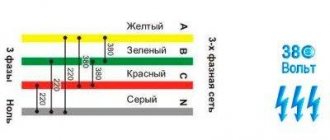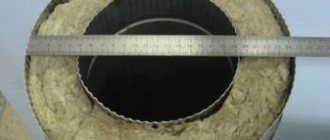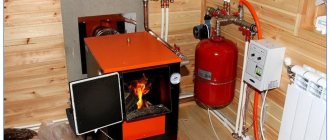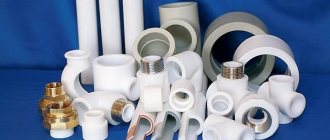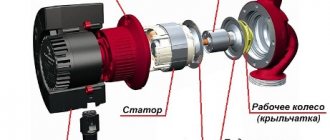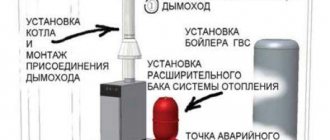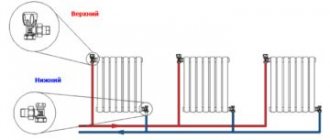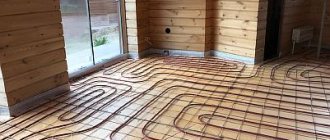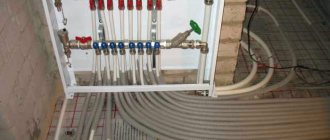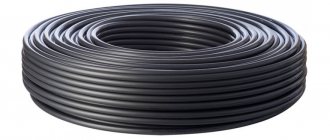Types of electric boilers
Depending on the method of transferring thermal energy to the coolant, electric boilers are divided into three types:
- Tenovye.
- Induction.
- Electrode.
All these heating units are produced in two versions: 220 and 380 volts.
Heating boilers
These electric boilers for home heating are the most popular. The principle of their operation is as follows:
- The tubular element heats the water circulating in the closed system.
- Circulation ensures fast and uniform heating of the entire system.
- The number of heating elements required depends on the power of the device and can vary from 1 to 6 heating elements.
Such boilers are equipped with a reliable automation system that allows you to monitor and regulate the temperature of the coolant. The advantages of heating elements heating units are:
- Simplicity and reliability of design.
- Easy to install.
- Cheap design.
- The ability to use almost any liquid as a coolant.
- These 380 volt boilers have a modern design and fit well into any interior.
Induction boilers
The principle of electromagnetic induction has long been successfully used for heating residential premises. This boiler has the following device:
- A metal core is inserted into a cylindrical body (usually a piece of pipe), on which a coil is wound.
- When voltage is applied to the coil and winding, vortex flows arise, as a result of which the pipe through which the coolant circulates heats up and transfers heat to the water.
- The water circulation must be constant so that the coil and core do not overheat.
This electric heating system has the following advantages:
- High efficiency, reaching 98%.
- This 380 volt boiler is not susceptible to scale formation.
- Increased safety - no heating elements.
- Small dimensions and low weight ensure easy and quick installation of induction boilers.
Electrode systems
In its operation, the 380 volt electrode boiler uses specially prepared water. Preparing the coolant involves dissolving a certain amount of salts in it to give the required density. The general operating principle of electrode heating devices is as follows:
- Two electrodes are inserted into a pipe of suitable diameter.
- Due to the potential difference and frequent polarity changes, the ions begin to move chaotically. This way the coolant heats up quickly.
- Due to the rapid heating of the coolant, powerful convection currents are created, allowing you to quickly warm up a large volume without the use of a circulation pump.
The electrode boiler has obvious advantages, including:
- Small sizes.
- Fast ramp up to rated power.
- Compact and simple design.
- No emergency situation, even if water leaks from the heating system.
The impact of temperature on the characteristics of the coolant
In addition to the factors listed above, the temperature of the water in the heating pipes affects its characteristics. The method of functioning of gravity heating systems is based on this. As the water heating value increases, it expands and circulation appears.
Coolants for heating systems
But when using antifreeze, exceeding normal temperatures in radiators can lead to different results. Therefore, for heating with a coolant other than water, it is necessary to first determine the permissible heating values. This does not apply to the temperature of the central heating radiators in the apartment, since such devices do not use antifreeze-based liquids.
Antifreeze is used if there is a risk of exposure to low temperatures on radiators. Unlike water, it does not change from liquid to crystalline at 0 degrees. But if the heat supply operation exceeds the norms of the temperature table for heating to a greater extent, the following phenomena may be observed:
- foaming This contributes to an increase in coolant volume and pressure level. There will be no reverse process when the antifreeze cools;
- the appearance of limescale. Antifreeze contains mineral components. If the heating temperature in the apartment is violated, they precipitate. Over time, this leads to clogged pipes and radiators;
- increase in density. Malfunctions of the circulation pump may occur if its rated power was not designed to handle such situations.
We recommend: Which radiators are best suited for autonomous heating?
Therefore, it is much easier to monitor the water temperature in the heating system of a private home than to control the heating level of antifreeze. Moreover, substances based on ethylene glycol emit gases that are harmful to humans when evaporated.
Today they are almost never used as a coolant in autonomous heating systems. Before using antifreeze in heating, it is necessary to replace all rubber seals with paranitic ones. This is due to the high level of permeability of this type of coolant.
Options for normalizing heating temperature
Minimum water temperatures in the heating system are not considered the main threat to its operation. This affects the microclimate in living rooms, but does not affect the operation of the heating supply. If the water heating norm is exceeded, emergency situations may occur.
Safety group for autonomous heating
When creating a heating scheme, you need to provide a list of measures aimed at preventing a critical increase in water temperature. First of all, this will lead to increased pressure and stress on the inside of pipes and radiators. If this happened once and lasted a short time, then the heating parts will not be damaged.
But such cases appear under the constant influence of specific factors. Most often this is the incorrect operation of a solid fuel boiler. To avoid breakdowns, it is necessary to upgrade the heating in the following way:
- installation of a security group. It consists of an air vent, a bleed valve and a pressure gauge. If the water temperature reaches a critical level, these parts will eliminate excess coolant, thereby ensuring normal circulation of the liquid for its natural cooling;
- mixing unit. It connects the return and supply pipes. Additionally, a two-way valve with a servo drive is mounted. The latter is connected to the temperature sensor. If the heating level exceeds the norm, the valve will open and a mixing of hot and cooled water flows will occur;
- electronic heating control unit. It distributes the water temperature in different parts of the system. If the thermal regime is violated, it sends a corresponding signal to the boiler processor to reduce power.
These measures will prevent improper heating operation at the initial stage of the problem. It is most difficult to control the water temperature in systems with a solid fuel boiler
Therefore, for them, special attention must be paid to the selection of indicators of the safety group and mixing unit
YouTube responded with an error: Access Not Configured. YouTube Data API has not been used in project 268921522881 before or it is disabled. Enable it by visiting https://console.developers.google.com/apis/api/youtube.googleapis.com/overview?project=268921522881 then retry. If you enabled this API recently, wait a few minutes for the action to propagate to our systems and retry.
Calculation of heating operating temperature conditions
When calculating heat supply, it is necessary to take into account the properties of all components. This is especially true for radiators. What is the optimal temperature for heating radiators – +70°C or +95°C? It all depends on the thermal calculation, which is performed at the design stage.
An example of drawing up a heating temperature schedule
First, it is necessary to determine the heat losses in the building. Based on the data obtained, a boiler with the appropriate power is selected. Then comes the most difficult design stage - determining the parameters of the heat supply batteries.
They must have a certain level of heat transfer, which will affect the temperature chart of the water in the heating system. Manufacturers indicate this parameter, but only for a certain operating mode of the system.
If to maintain a comfortable level of air heating in a room you need to spend 2 kW of thermal energy, then the radiators must have a no less heat transfer rate.
To determine this, you need to know the following quantities:
- The permissible maximum water temperature in the heating system is t1. It depends on the power of the boiler, the temperature limit on the pipes (especially polymer ones);
- The optimal temperature that should be in the heating return pipes is t This is determined by the type of pipeline layout (one-pipe or two-pipe) and the total length of the system;
- The required degree of heating of the air in the room is t.
Having these data, you can calculate the temperature difference of the battery using the following formula:
Tnap=(t1-t2)*((t1-t2)/2-t3)
Next, to determine the power of the radiator, use the following formula:
Q=k*F*Tnap
Where k is the heat transfer coefficient of the heating device. This parameter must be indicated in the passport; F – radiator area; Tnap – thermal pressure.
By varying various indicators of the maximum and minimum water temperatures in the heating system, you can determine the optimal operating mode of the system. It is important to correctly initially calculate the required power of the heating device. Most often, the low temperature indicator in heating radiators is associated with heating design errors. Experts recommend adding a small margin to the obtained radiator power value - about 5%. This will be needed if the outside temperature drops critically in winter.
Most manufacturers indicate the heat output of radiators according to accepted standards EN 442 for mode 75/65/20. This corresponds to the normal heating temperature in the apartment.
Battery temperature
There are minimum and maximum standards. Sometimes, even when heating is started, there is not enough heat in the room due to the fact that the temperature of the radiators is far from the standards. The reason for this is the banal airiness of the system. You can fix the problems with the help of a specialist or yourself using a Mayevsky crane.
If the problem arises due to worn-out riser pipes or batteries, then you simply cannot do without the help of specialists. If the heating system did not work and the air in the apartment was colder than specified in GOST standards, then this entire period is not subject to payment.
There are no minimum temperature standards for heating radiators, so it is customary to rely on the air parameters in the apartment. Normal air parameters during the heating period are +16…+25°C.
To document that the temperature of the heating system does not meet the norm, it is necessary to invite an authorized representative of the heating service provider. What the water temperature in the batteries should be is described in SNiP 41−01 of 2003:
- If a two-pipe design is used in the room, then 95°C is the maximum.
- The norm for a single-pipe design is +115°C.
- The winter temperature norm for heating radiators in an apartment is +80…+90°C. If it approaches +100°C, then urgent measures must be taken to prevent water from boiling in the system.
To ensure that the heating complies with GOST standards, you need to take your own measurements and understand what the temperature of the water in the heating radiators is:
- An ordinary mercury thermometer can be used, but then 2°C will need to be added to the result obtained.
- An infrared thermometer will also work.
- The alcohol thermometer must be tightly tied to the battery, wrapped in thermal insulation.
If the results obtained are far from normal, then you need to submit an application to the heating network office with a request to carry out control measurements. A commission will visit the apartment and make all the necessary calculations.
Comparison by other characteristics
One feature of battery operation – inertia – has already been mentioned above. But in order for the comparison of heating radiators to look objective, in addition to heat transfer, other important parameters should be taken into account:
- working and maximum coolant pressure;
- amount of water held;
- weight.
The operating pressure limitation determines whether the heating device can be installed in multi-storey buildings, where the height of water lifting by network pumps can reach hundreds of meters. The parameter does not matter for private houses, where the pressure in the system is low, maximum 3 Bar.
Comparing the capacity of radiators can give an idea of the total amount of water in the network that will have to be heated. Well, the weight of the product is important when choosing the installation location and method of attaching the battery.
As an example, below is a comparison table of the characteristics of various heating radiators of the same size:
Procedure in case of no heating
Residents of apartment buildings are sometimes faced with a situation where the apartment is already very cold, and the temperature of the radiator in the apartment is not only below normal - the heating is completely turned off. If the reason for this is a breakdown of the heating system in the house, they must be eliminated
But if the culprit of the delay is the service company, it is important to provide evidence that the apartment is very cold
A representative is invited from the service company and together with him they measure the temperatures in each room, recording the results in writing. After receiving the results, the heat supplier must urgently take measures to turn on the heating and recalculate the charge for the period of interruption. In the absence of any response from the service organization, compensation can be obtained through the court for violation of the rules for servicing the population by utility companies.
In winter, the minimum air temperature in the apartment is 18 ℃. Provided that the temperature falls below this level, the heat supplier must reduce the payment by 0.15% for each hour of the violation period.
The water temperature standards in house heating radiators must comply with SNiP and be strictly observed throughout the heating season.
To protect themselves from violations by heat suppliers, consumers should familiarize themselves with the standards, deadlines and temperature limits of water in radiators and indoor air during the heating season. Then, if necessary, they can check all values with simple measurements.
If there is any discrepancy between the heating system and GOST, you need to find the cause of the cold radiators. The best person to deal with this will be the specialists of the supplier company, who will be able to officially record the temperature in the living room.
If the problem is caused by poor quality maintenance of the systems of an apartment building, then the solution to the problem lies entirely with the organization supplying the heat. At the same time, all residents should be recalculated for heat or they should be completely exempt from paying if the radiators did not heat at all.
Knowing what the temperature of the radiators in the apartment should be and at what period the heating starts, each resident of an apartment building can determine for himself whether the temperature indicators comply with the established standards. This will help you take action in time and solve the heat problem.
Correct measurements of room temperature
In order to comply with heating standards in a residential building, it is recommended to carry out mandatory temperature measurements. To obtain reliable results, measurements are performed with a special device taking into account the following technical requirements:
- Readings are taken every hour for one calendar day
- The device must be located at certain points - 100 cm from the external wall, 150 cm from the floor surface
- The room in which measurements are taken should not have sources of heat loss - cracks, open windows and doors
- Measurements are carried out under neutral weather conditions
If, as a result of independent measurements, a decrease in the standard comfortable temperature in the apartment is determined, this is reported to the emergency service.
In this case, the duty officer sends a team to the resident to draw up an official measurement report.
The act contains the following data:
- Date of document creation
- Technical information of housing
- Inspecting staff
- Meter data
- Temperature values
- Signatures of participants
The document is drawn up in two copies: one for the owner of the living space, the second for the employees of the public utility service.
How to correctly measure and find the average standard
The heating is turned on in your house and you want to measure the air temperature in the apartment, but you don’t know how to do it correctly? Now let's clarify this issue.
To do this you need to use a certain method:
In each room, a thermometer is placed on the inside of the wall.
It should be located at a distance of one meter from the outer wall and one and a half meters from the floor surface. Measurements are taken for at least ten minutes.
Users of residential premises in apartment buildings must receive heating services continuously and around the clock throughout the entire established period.
The permissible rate of heating failure is no more than one day within thirty days (24 hours in total).
At a time, no more than 14 - 16 hours (the air temperature in the rooms should remain at least twelve degrees).
If the air temperature in the living room is ten to twelve degrees, no more than eight hours.
And no more than four hours if the temperature is eight to ten degrees.
If the standards are not met, the heating fee for each hour must be revised and reduced by 0.15%.
Now take a calculator and do some simple calculations and find out how much you should pay for batteries that are barely warm.
Perhaps some individuals do not agree with the established norms and requirements of legal acts.
If the temperature in your apartment corresponds to the requirements, but you do not agree with it (this is not enough for you), then in this case there is only one way out - buy a heater.
For many, this is a way out of the situation so as not to freeze.
And if, on the contrary, you feel hot, you can adjust the temperature using a thermal head installed on the radiator.
But keep in mind that in this case you will have to pay for the services provided in full. There will be no concessions to you from the service organization.
Of course, you can only pay for the heat you used; for this you will have to install heating heat meters.
The standard temperature in a living space in winter, according to SanPiN, is predetermined in conjunction with such indicators as air humidity and air flow speed.
This applies only to rooms in which the optimal humidity value is between 30 and 45%.
For other premises, these parameters are not standardized. In this case, air flows should move at a speed of 2 m/s.
So, we have figured out the air temperature in the apartment during the heating season and found out the permissible errors in one direction or another.
Temperature standards
The heating circuit of a residential multi-storey building interacts with a centralized system to which pipes are connected. Through them, water flows into the apartment building, where it is subsequently regulated by valves. Then it flows through the risers into the radiators and radiators of each residential premises. The parameters of the heating system coolant are established by regulations. As a rule, it should be brought to a temperature of 130-150°C. But this indicator is affected by the temperature outside. Basically, the water temperature at the boiler outlet is 115°C. According to regulations, the temperature in the heating system can be 95-105°C. In order for comfortable conditions to be created in the apartment, the proper condition of the parameters of the riser through which water from the heating unit is delivered to the apartment must be ensured. Depending on the season, parameters may vary. In winter, the riser should be heated to 70-90°C.
How everything works
There are two different types of charts:
- For heating networks.
- For indoor heating system.
The relationship between supply temperatures in the route and in the house.
To explain the difference between these concepts, it is probably worth starting with a brief excursion into how central heating works.
CHP - heating networks
The function of this bundle is to heat the coolant and deliver it to the end user. The length of heating mains is usually measured in kilometers, the total surface area is measured in thousands and thousands of square meters. Despite measures to insulate pipes, heat loss is inevitable: after traveling from the thermal power plant or boiler room to the border of the house, process water will have time to partially cool.
Hence the conclusion: in order for it to reach the consumer while maintaining an acceptable temperature, the supply of the heating main at the exit from the thermal power plant must be as hot as possible. The limiting factor is the boiling point; however, as the pressure increases, it shifts towards increasing temperature:
| Pressure, atmosphere | Boiling point, degrees Celsius |
| 1 | 100 |
| 1,5 | 110 |
| 2 | 119 |
| 2,5 | 127 |
| 3 | 132 |
| 4 | 142 |
| 5 | 151 |
| 6 | 158 |
| 7 | 164 |
| 8 | 169 |
Typical pressure in the supply pipeline of a heating main is 7-8 atmospheres. This value, even taking into account pressure losses during transportation, allows you to start a heating system in buildings up to 16 floors high without additional pumps. At the same time, it is safe for routes, risers and connections, mixer hoses and other elements of heating and hot water systems.
Inside the flexible hoses of the mixer the pressure is the same as in the heating main.
With some margin, the upper limit of the supply temperature is taken to be 150 degrees. The most typical heating temperature curves for heating mains are in the range of 150/70 – 105/70 (supply and return temperatures).
House
There are a number of additional limiting factors in a home heating system.
The maximum coolant temperature in it cannot exceed 95 C for a two-pipe and 105 C for a single-pipe building heating system.
A row of heating radiators stretches along the walls.
For obvious reasons, the temperature delta between the supply and return pipelines should be as small as possible - otherwise the temperature of the batteries in the building will vary greatly. This implies rapid circulation of the coolant. However, too fast circulation through the house heating system will lead to the return water returning to the route at an excessively high temperature, which is unacceptable due to a number of technical limitations in the operation of thermal power plants.
The problem is solved by installing one or more elevator units in each house, in which return water is mixed with the flow of water from the supply pipeline. The resulting mixture, in fact, ensures rapid circulation of a large volume of coolant without overheating the return pipeline of the route.
Elevator operation diagram.
For intra-house networks, a separate temperature schedule is set taking into account the elevator operation scheme. For two-pipe circuits, the typical heating temperature curve is 95-70, for single-pipe circuits (which, however, is rare in apartment buildings) - 105-70.
Parameters for starting heating
As autumn approaches, the temperature outside becomes lower and lower, people touch their batteries every day and hope that today they will become hot. If this does not happen, then the residents look for the culprits, but in fact, all standards for the supply of heat to houses are specified in Resolution No. 354 of 2011.
This document states that heat is supplied at an outside temperature of 8 degrees Celsius, if it lasts for five days in a row . If this indicator fluctuates in one direction or the other over the specified time, then the radiators and risers in the apartments will remain cold.
Heat is supplied only on the sixth day and, as a rule, in most cases the heating season begins on October 15 and ends on April 15.
In this video you will learn the temperature standards in the apartment:
Requirements for heating networks
With centralized heat supply, the heat source is a boiler house or a thermal power plant, where high-temperature water-heating boilers are installed (in thermal power plants - steam boilers). The fuel is usually natural gas, with other energy sources being used to a lesser extent. The temperature of the coolant at the outlet of the hot water boiler is 115 °C, but the water does not boil when it is under pressure. The need to heat up to 115 °C is explained by the fact that boiler plants operate at maximum efficiency in this mode.
The transition from 115 °C to the required temperature value is provided by plate or shell-and-tube heat exchangers. At a thermal power plant, waste steam from turbines enters heat exchangers to produce electricity. According to regulatory requirements, the water temperature in heating pipes should not exceed 105 ° C, the lower limit depends on street conditions. In this range, the heating of water in the heating network is regulated depending on the weather, for which each boiler room has a temperature graph of the heating system. For home networks, 2 calculation schedules are used:
- 105/70 °C;
- 95/70 °C.
These figures show the maximum temperature of the supply and return water during the most severe frosts in a particular area. But at the beginning and end of the heating season, when the weather is not yet too cold, there is no point in heating the coolant to 105 °C, so a real temperature heating schedule is drawn up, which describes to what extent the water should be heated at different outside temperatures. The dependence of heating on weather conditions is shown in the table, which presents excerpts from the graph for the city of Ufa:
| Temperature, °C | |||
| street air average daily | on feed with design schedule 105/70 | on supply with a design schedule of 95/70 | in the return |
| +8 | 43 | 41 | 36 |
| 56 | 52 | 43 | |
| -5 | 64 | 59 | 48 |
| -10 | 71 | 65 | 52 |
| -15 | 78 | 72 | 56 |
| -20 | 85 | 78 | 59 |
| -25 | 92 | 84 | 63 |
| -30 | 99 | 89 | 67 |
| -35 | 105 | 95 | 70 |
It is quite difficult to find out exactly what the coolant temperature is in a centralized heating network. To do this, you need to have a remote thermometer that determines the degree of surface heating. So, it is possible to determine to what extent the heating standards in the apartment are met only by the air temperature in the rooms.
Calculation of the optimal temperature of the heating device
The most important thing is that the most comfortable temperature for human existence is +37°C.
When choosing a radiator, you need to calculate whether the thermal power of the device is enough to heat the room. There is a special formula for this:
When choosing a radiator, you need to calculate whether the thermal power of the device is enough to heat the room. There is a special formula for this:
S*h*41:42,
- where S is the area of the room;
- h – room height;
- 41 – minimum power per 1 cubic m S;
- 42 – nominal thermal conductivity of one section according to the passport.
When you use a radiator to maintain the desired temperature in a room, you have two options: you can use small radiators and increase the water temperature in them (high temperature heating) or install a large radiator, but the surface temperature will not be as high (low temperature heating) .
With high temperature heating, radiators are very hot and can cause burns if you touch them. In addition, at a high temperature of the radiator, the decomposition of dust settled on it may begin, which will then be inhaled by people.
When using low temperature heating, the appliances are slightly warm, but the room is still warm. In addition, this method is more economical and safe.
Cast iron radiators
The average heat output of a separate section of a radiator made of this material ranges from 130 to 170 W, due to the thick walls and large mass of the device. Therefore, it takes a lot of time to warm up the room. Although this also has the opposite advantage - high inertia ensures long-term retention of heat in the radiator after the boiler is turned off.
The coolant temperature in it is 85-90 °C
Aluminum radiators
This material is lightweight, easily heats up and has good heat dissipation from 170 to 210 watts/section. However, it is susceptible to the negative effects of other metals and may not be installed in every system.
The operating temperature of the coolant in the heating system with this radiator is 70°C
Steel radiators
The material has even lower thermal conductivity. But due to the increase in surface area with partitions and ribs, it still heats well. Heat output from 270 W is 6.7 kW. However, this is the power of the entire radiator, and not of its individual segment. The final temperature depends on the dimensions of the heater and the number of fins and plates in its design.
The operating temperature of the coolant in the heating system with this radiator is also 70°C
So which one is better?
It will probably be more profitable to install equipment with a combination of the properties of an aluminum and steel battery - a bimetallic radiator. It will cost you more, but it will also last longer.
The advantage of such devices is obvious: if aluminum can withstand the temperature of the coolant in the heating system only up to 110°C, then bimetal can withstand up to 130°C.
Heat transfer, on the contrary, is worse than that of aluminum, but better than that of other radiators: from 150 to 190 W.
Warm floor
Another way to create a comfortable temperature environment in the room. What are its advantages and disadvantages over conventional radiators?
From a school physics course we know about the phenomenon of convection. Cold air tends to fall, and when it warms up, it rises. That’s why, by the way, my feet get cold. A warm floor changes everything - the heated air below is forced to rise upward.
This coating has a high heat output (depending on the area of the heating element).
The floor temperature is also specified in SNiP-e (“Building Norms and Rules”).
In a permanent home it should not be more than +26°C.
In rooms for temporary stay of people up to +31°C.
In institutions where children are taught, the temperature should not exceed +24°C.
The operating temperature of the coolant in the underfloor heating system is 45-50 °C. Surface temperature averages 26-28°C
